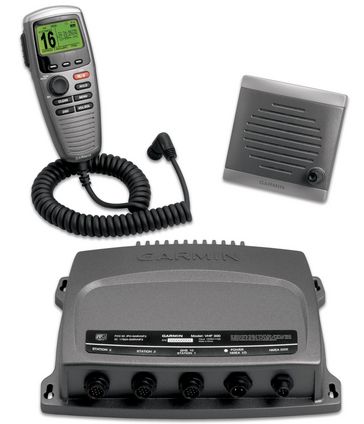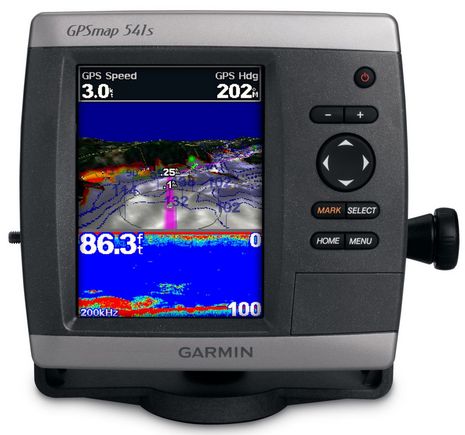Garmin VHF 300 AIS, xHD Radar & more
Garmin announced a slew of new products yesterday, the most innovative of which is probably the black box VHF 300 AIS. I think that this is not only the first combination VHF radio and AIS receiver (aside from the mod Icom UK apparently came up with), but also the first AIS receiver with NMEA 2000 output. While there are a couple of issues with N2K AIS target messages right now, I’m confidant they’ll be fixed soon, and this will become the way to go. For instance, a Garmin plotter should
easily be able to “direct dial” AIS targets, buddies included, using
N2K. But that’s not all to like about this radio…
Garmin smartly borrowed the “rewind” audio memory feature first seen on fixed and portable Cobra radios, which is very useful for boaters like me who monitor VHF at low volumn (and may also be slightly short on listening skills, or so I’m told ;-). The VHF 300 AIS can also track three non-AIS-equipped vessels, using automated DSC polling presumably, and Garmin came up with a way to record a short audio message that will play if
you don’t pick up a private DSC call, which may handy if we ever get in the habit of using DSC to call each other. Which may happen when there are enough radio and multifunction display (or PC) combinations that make MMSI numbers more useful and easier to handle (as Garmin is obviously trying to do).
On the other hand, this system
lists for $1,000 before you add 2nd and 3rd GHS 10 handsets, and I suspect that a lot of boats in that budget range will want a full Class B AIS transponder. But Garmin has also introduced the plain VHF 300, which has all the same features minus the AIS receivers. I imagine that a Garmin MFD connected to this radio and anyone’s Class B transponder is going to work pretty well (and I hope to soon experiment with the VHF 200 which is just shipping). I would hope that eventually Garmin’s N2K VHF radios, as well as everyone else’s (hello Icom and Standard Horizon?) would play nicely with any device that can use MMSI numbers to iniate calls, collect DSC calls, or whatever. But I doubt, for instance, that the Simrad AI50 I’m testing will be able to place a call on the Garmin VHF 200, again, I think, because NMEA has been slow to create the
needed standardized commands.
Garmin also announced those four new radar arrays we got tipped off on a while back. They range from the GMR 604 xHD to the 1206 xHD, and I understand now that the xHD name is meant to distinquish their higher sampling rate from the HD technology available in their 18- and 24-inch domes. Finally, the company also refreshed their whole complicated line of 4- and 5-inch plotters and plotter/sounders. The changes are probably best understood from the press release, but what stood out for me was the addittion of NMEA 2000, which catches Garmin up with Lowrance’s smaller HDS units and Raymarine’s new A Series. I don’t know how well Garmin’s new 3D charting — introduced to networked MFD’s with software release 5.0, and seen below — will work on small screens, but I’ve been using it on a 5212 recently, and am really getting fond of it.















Correction (thanks, René!): The first production DSC VHF & AIS receiver combo is probably the Navicom RT-650. I can’t find the manufacturer’s web site (anyone?), but did locate this short review from Yachting Monthly:
http://tinyurl.com/lu7l5t
at first, Icom IC-M505 & IC-M603
then Navicom RT-650
then Furuno RO-4800
Responding to the relentless pressure from certain unnamed marine electronics correspondants, NMEA today released the latest update of NMEA2000 with AIS B stuff.
Thanks, Peio, but I don’t think that RO-4800 is made by Furuno. It looks like Furuno France, a distributor, is reselling the Navicom RT-650:
http://www.radio-ocean.com/pages/main2.html
And thank you, Sandy, once again, for a smile.
Here’s the press release from NMEA about ver 2.10 of N2K. Looking over the corrugendae it appears there were some corrections made to some of the older class A pgn’s too.
http://www.tradeonlytoday.com/home/498866-nmea-releases-new-version-of-standard
Am I the only one who finds the Garmin menu system on the 440 / 540 series cumbersome? Compared to other products I have used, it takes a lot of key strokes to change a setting, and get back to the display I was on….
Any new interface will seem confusing or obtuse simply because we rely on “muscle memory” for routine tasks, but new stuff requires us to pay more direct attention until we have retrained our hands. Its harder for a person used to the older Garmin interface to learn the new one than it is for a newcomer or someone switching from a more visually cued device. This is exactly what computers were like before Windows, and its the reason that programs that use a different look and feel aren’t as marketable.
A friend of mine is a delivery captain who has had to learn virtually every Nav system out there. He relies on a Garmin 276 to really know where he is and how to get somewhere else without hitting anything.
Yes, I find it cumbersome also, but maybe because I am use to full size chartplotters.
The underlying functionality, appeareance, and other elements of the GUI are very very well done … but standing between you and that, is a limited palete of controls, none of them being soft keys (function appears on screen next to a button), means click click click click click thru menu’s. It’s especially annoying in the weather options as you need to go thru different menus to see different elements of the realtime or forcasted weather information … and if it’s raining it blots out the chart, causing you to switch between no weather at all, back and forth.
On the larger touch screen charplotters you just touch your selection in the menu, which brings you so much closer to the genius in underlying functionality, appeareance, and other elements of the GUI that are innovative. For the smaller chartplotter, since most menu’s have less then six choices, it would have been ideal if they put six soft keys down the left side of the smaller chartplotters, otherwise added a way to select items from a menu with one button, or made the smaller units touch as well.
Still, there is much to like about this product specifically rich featuers, very very low power consumption, integrated XM weather and music (just add antenna and speakers), and more.
I’m looking at a picture of a 546, and I don’t see a good place to put buttons, or on-screen selections for that matter, on a unit this small. Perhaps a touch-screen is even more useful on a small screen than on the big ones!
I find the Garmin 400-500 menus a pain also,I seem to be forever hitting menu or home.(our Garmin sales rep admitted he doesn’t like the new menu either).For a small chartplotter I would chose the standard horizon 180 or 300,better menu I think.
For best menu I would say Raymarine has it.
Ben; I have been waiting for the Garmin VHF200 for testing as well. I am wondering why the launch date was pushed out? The 300 looks very interesting but until Garmin comes out with a AIS Class B transponder I will continue to use my NAIS300L. I am also happy with the Lowrance LVR880’s performance on my N2K network. As an FM entertainment radio, well I certainly didn’t purchase it for that.
Bill
40 Mainship Sedan Bridge
Tuckerton, N.J.
I have been using the 545S since newly introduced (2 years?) and found it both a clumsy and fumblesome UI. But the recent update of the version (11/2009) provided has improved the UI, like it now makes better usage of existing keys. Now you can use the zoom keys (+/-) to scroll a list instead of the having a very long scroll and a press of the Back button, just to continue with a scrollable list. This is only one example in new EPROM version upgrade has improved the UI on my 545s. But the one issue I have had with the Garmin as a main GPS NAV drive to my AP50 (Simrad AP) has been the intercept. Garmin way over does the course change vector and its a bit scary to the Admiral when I push NAV? key again on the AP 50 to except the course change. However, I have a new trick that seems to change how sharply the AP 50 will change course. All I have to do now is turn the NFU knob on the AP50 to reduce the rate of turn provided for by the Garmin. Note that I did make significant comments to Garmin concerning their algorithm, and their response was it was better to throw the boat on the rub line than to softly merge onto the NAV course. Now that I have a workaround, I just have to remember to turn the knob before accepting a Garmin supplied value! But my biggest complaint of all is the cost of the charts and the fact I have to carry more than one version to run my GP76x, Nobeltec, and 545s. Who’s gonna solve that problem! We need a chart standard too! And one were I don’t have to pay three times for the exact same chart! LOL!
Hi Ben: do you think the Garmin 300 AIS is still a viable unit ? I have looked at it lots and have been thinking of adding one with a plotter update but 2009 to 2016 is a lot of time ! It looks like a lot of Mao era Chinese technology.